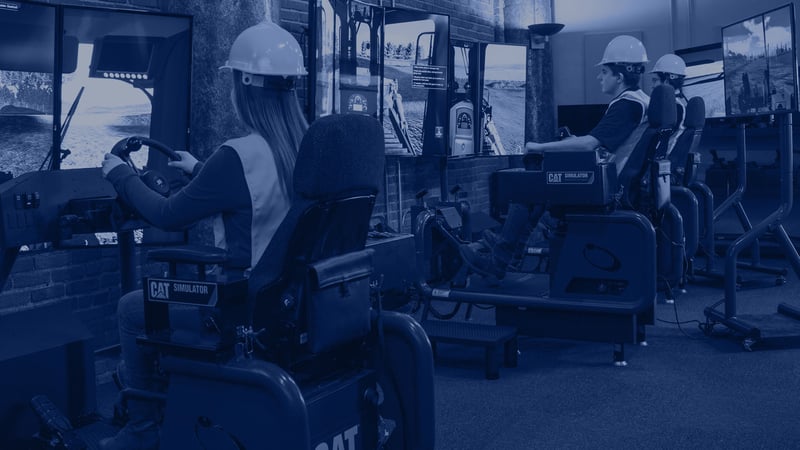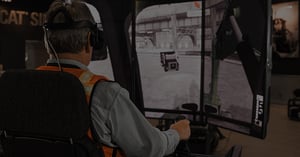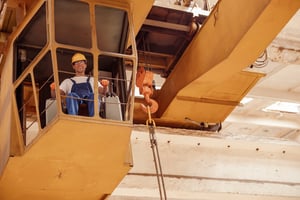Construction: Preventing Equipment Tip-Overs & Load Instability
Operating heavy machinery in any industry, but specifically in construction, requires a keen sense of balance and coordination—skills that are difficult to develop in a static training environment.
For example, imagine a trainee learning to maneuver an excavator on rough, sloped terrain. On a static simulator, they can see the machine tilting on-screen, but they don’t physically feel the shifting balance. Without the sensation of instability, recognizing early warning signs and adjusting becomes much harder.
With D-BOX’s haptic feedback, motion simulators replicate the physical forces operators would experience in the field, allowing them to develop critical instincts:
- Feeling the tilt before a tip-over – D-BOX’s motion systems simulate the subtle shifts of an excavator tilting, helping trainees learn to feel instability early and make real-time adjustments to prevent accidents
- Recognizing machinery strain – Vibrations mimic real-world stress on the excavator, teaching operators to adjust speed and pressure when digging or lifting to avoid mechanical strain
- Mastering load balance – The weight shift in the seat when lifting heavy loads trains operators to counterbalance properly, preventing dangerous shifts that could destabilize the machine and lead to a tip
With motion-enabled simulators, trainees aren’t just learning procedures—they’re developing the instincts that will keep them safe and efficient on the job site, long before they ever step into real equipment. By experiencing realistic forces and vibrations in a controlled environment, trainees build muscle memory and reaction speed that static simulations simply can’t provide. This leads to fewer accidents, safer operations, and more confident operators.
Flight Simulation: Mastering Extreme Weather & Emergency Response
Pilots must be prepared for unpredictable conditions from extreme weather to critical system failures. While flight simulators are an essential part of pilot training, static simulators fall short in one key area: physical feedback.
Imagine a pilot in training flying through intense crosswinds or sudden heavy rain. In a static simulator, they can see the effects on their instruments, but without physical cues, they won’t develop the instinctive feel for these potentially dangerous scenarios. Their reactions are purely visual and delayed, making it harder to adapt to rapidly changing in-air conditions.
With motion simulators, pilots experience the same physical forces they would in an actual aircraft, helping them develop crucial instincts:
- Experiencing extreme weather – Motion replicates the physical forces of wind gusts, turbulence, and rapid pressure changes, helping pilots anticipate and counteract the instability caused by severe weather.
- Feeling g-forces during takeoff & landing – The physical sensation of acceleration and deceleration trains pilots to better understand aircraft response times, reinforcing proper handling techniques.
- Engine failure drills – Sudden haptic feedback mimics an engine shutdown, forcing pilots to adjust their controls before they even check their instruments, improving their ability to react under pressure.
By incorporating motion cues into training, pilots don’t just learn flight procedures—they develop the muscle memory and instincts needed to react faster and more effectively in real-life scenarios.

Emergency Vehicle Training: Navigating Traffic & High-Speed Emergency Response
For first responders, every second counts when rushing to the scene of an emergency. Whether it's a police officer responding to a crime, an ambulance racing to an accident, or a fire truck maneuvering through congested streets, navigating traffic safely at high speeds is a critical skill. A single wrong move can lead to collisions, delays, or even additional casualties—yet this kind of training is nearly impossible to practice in real-world conditions.
On motion simulators, trainees can experience the same physical forces they would if they were weaving through traffic, having to brake or accelerate suddenly—but in a safe, controlled environment.
- Weight transfer feedback – Feeling how an ambulance, fire truck, or police cruiser shifts weight when swerving, accelerating, or braking teaches drivers to adjust steering and throttle for smoother, safer handling.
- Emergency braking simulation – Haptic feedback replicates the pulsations of ABS braking, helping trainees learn how to brake effectively without skidding or losing control—especially on wet or uneven roads.
- Navigating tight spaces & sudden lane changes – Motion simulation mimics the subtle vibrations of road conditions and the force of rapid turns, helping drivers anticipate vehicle reactions when dodging obstacles in traffic.
By experiencing these forces firsthand, first responders don’t just learn emergency driving techniques—they build the muscle memory and reflexes needed to react instinctively in high-pressure situations. With motion simulation, they can train for real emergencies without real-world risks—so when the call comes in, they’re fully prepared to get there safely and on time.
Motion is the Missing Link in Professional Training
When it comes to training for high-risk, high-stakes professions, static simulators can only take trainees so far. While they help develop procedural knowledge, they lack the physical feedback needed to build real-world instincts—whether it's feeling the weight shift of an excavator on unstable terrain, reacting to extreme weather in a flight simulator, or making split-second decisions while navigating traffic in an emergency vehicle.
This is where motion simulation makes the difference. By integrating realistic movements, vibrations and textures, D-BOX’s haptic technology bridges the gap between theory and hands-on experience. This allows trainees to develop reflexes, muscle memory, and situational awareness in a safe, controlled environment!
With motion-based training, professionals don’t just learn how to operate equipment—they learn how to feel and react instinctively to real-world conditions. And in industries where seconds matter and precision saves lives, that difference can be game-changing.
Want to improve your training programs? Discover how D-BOX motion systems can take your professional simulation to the next level.





